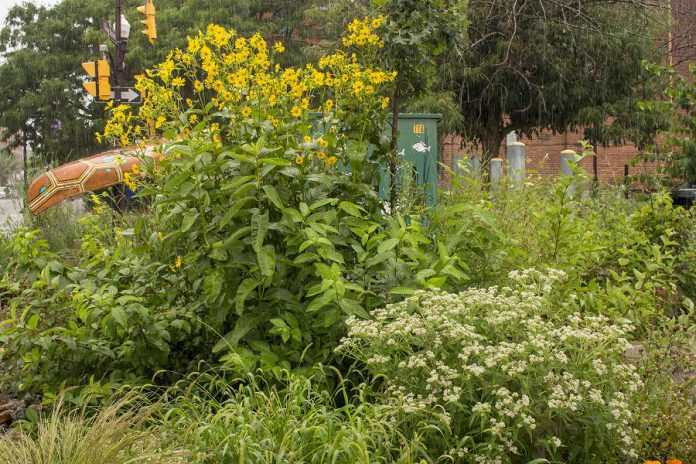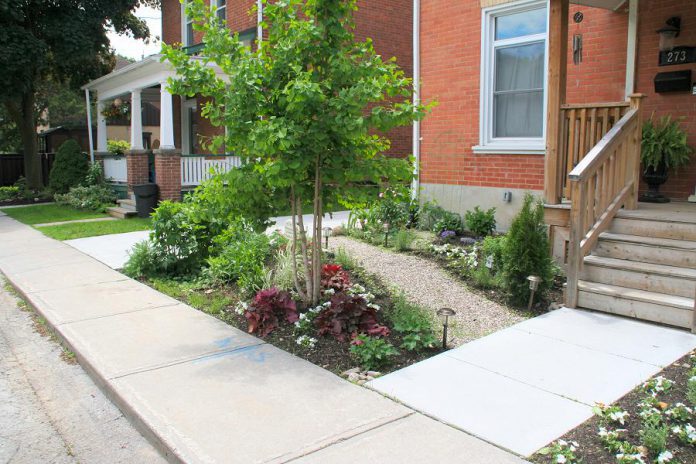
After one of the driest springs on record, July was 150 per cent wetter than average, with rainfall recorded every two of three days. This kind of weather-related volatility will become more common as climate change intensifies.
The good news is that installing a rain garden on your property can help manage these extremes.
In 2021, the City of Peterborough is once again offering subsidies of up to $500 to eligible homeowners who install rain gardens on their properties.
Why rain gardens?
A rain garden is a bowl-shaped garden that collects water from your roof, driveway, or other hard surface, and allows the water to drain into the ground instead of entering the stormwater system. Rain gardens are an important part of green urban infrastructure that keeps our waterways healthy.
“Currently, only 25 per cent of the City of Peterborough’s stormwater is filtered for pollutants before entering natural waterways, such as the Otonabee River or Jackson Creek,” explains Curtis Mei, the city’s stormwater systems coordinator.

“When it rains, urban runoff (stormwater) carries sediment and pollutants from vehicles, fertilizers, road salt, animal waste, and grass clippings into these waterbodies, which pollutes natural habitat and our source of clean drinking water,” Mei adds.
By diverting rainfall away from roads and sewers, rain gardens also reduce pressure on the municipal stormwater system, which in turn lowers the risk of localized flooding. This will become more important as rain events intensify.
All rain gardens share certain features, such as an inlet where water enters the garden and an outlet that allows for the safe overflow of rain during extremely heavy storms. Rain gardens also include a variety of plants. Beyond that, rain gardens come in all sizes, shapes, and styles.
Many trees, shrubs, grasses, sedges, and flowers are well-suited to rain gardens, including a number of native species. Moisture-loving plants — such as blue flag iris (iris versicolor) or river birch (betula nigra) — should be placed toward the centre of your garden, where conditions are wetter.
Plants that can tolerate longer periods of drought should be placed around the perimeter of the garden, where conditions are drier. Many of my favourite drought-tolerant species — such as butterfly milkweed (asclepias tuberosa) and prairie dropseed (sporobolus heterolepis) — work well on the edges of rain gardens.
If you’re concerned about mosquito habitat, don’t be. Rain gardens are not the same as ponds or bogs. They are designed to absorb water within about 24 hours, which isn’t enough time for mosquito larvae to develop. In fact, rain gardens are often quite dry.

So how does the City of Peterborough’s rain subsidy program work?
“A rain garden subsidy is a simple and effective way of providing financial support to residents of the City of Peterborough who provide stormwater management at the source, reducing the negative impacts of urban runoff,” Mei explains.
The first step is to complete a pre-application questionnaire through the City of Peterborough website at peterborough.ca, which will determine your eligibility and provide an estimated subsidy amount based on the roof area you intend to capture and your proposed garden size.
Rain gardens aren’t suitable for all properties. You need a location at least three metres (10 feet) from any building foundations. The area should also be free of tree roots and underground utilities. Rain gardens can be installed in either in front or back yards.
Next, applicants attend a design workshop hosted by GreenUP. The final design workshop of the 2021 season will be held on Zoom from 7 to 9 p.m. on Tuesday, August 24th. For more information or to register, visit greenup.on.ca/event/rain-garden-subsidy-program-design-workshop-2/.
Finally, applicants must draft their design, submit it for approval, and install the garden before the end of this fall.

If this sounds like a lot of work, keep in mind that GreenUP and city staff are available to assist residents throughout the process. Homeowners can also put the subsidy amount toward the cost of hiring a qualified landscaper to design and install a garden on their behalf.
“Building our rain garden was a great experience from start to finish,” explains Kat Tepylo-Murphy, one of last year’s subsidy recipients. “We enjoyed learning about the plants, building it, and talking to all our interested neighbours as we put it together.”
“The rain garden looks so much nicer than the grass we had before and we’re happy knowing that it helps the environment too,” Tepylo-Murphy adds. “We love watching it fill up on rainy days.”
Interested applicants and landscape contractors should plan to attend the August 24th workshop. Those who cannot attend but still wish to apply should contact program coordinator Hayley Goodchild at hayley.goodchild@greenup.on.ca.
Looking for further inspiration? Check out these demonstration rain gardens installed by GreenUP at the following locations: the Jiimaan’ndewemgadnong Pocket Park at the corner of King and Water streets (Euphoria Spa and the Depave Paradise rain garden at the corner of Brealey and Lansdowne streets.
For more information about the subsidy program and rain gardens, check out the City of Peterborough website and GreenUP’s Ready for Rain program.


























